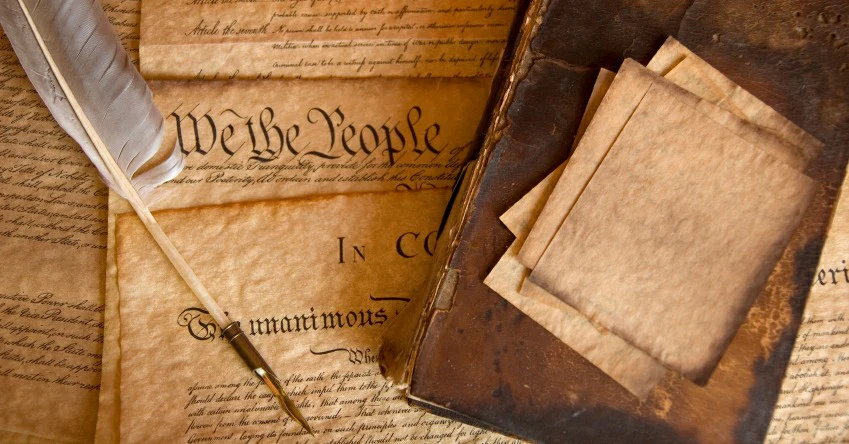After the American Revolution, the United States found itself in an awkward position: it had won independence but didn’t quite know how to govern itself. The Articles of Confederation, adopted in 1781, created a central government so weak it could barely function. By the mid-1780s, it was clear that the young nation was teetering on the edge of collapse. But out of this chaos emerged a remarkable journey—a path that would lead to the creation of the U.S. Constitution. This is the story of how America went from a loose alliance of states to a unified nation, and the key players who made it happen.

The Problem with the Articles of Confederation
The Articles of Confederation were designed to prevent the kind of tyranny Americans had just fought a war to escape. But in their effort to avoid a strong central government, the Founding Fathers created one that was too weak to function. Congress couldn’t tax, regulate trade, or enforce laws. States acted like independent countries, often bickering over borders, trade, and debt.
The result? Economic chaos, foreign policy failures, and internal unrest. By 1786, the situation had become dire. Farmers in Massachusetts, led by Daniel Shays, rebelled against high taxes and foreclosures in what became known as Shays’ Rebellion. The federal government, powerless to intervene, could only watch as the crisis unfolded. It was a wake-up call: America needed a new system of government.
The Visionaries: Hamilton and Madison
Enter Alexander Hamilton and James Madison, two young but brilliant minds who would become the architects of the U.S. Constitution.
- Alexander Hamilton: A self-made man from the Caribbean, Hamilton had risen to prominence as George Washington’s aide-de-camp during the Revolution. By 1783, he was a New York lawyer and a vocal advocate for a stronger central government. Hamilton’s experiences during the war had convinced him that the Articles of Confederation were a recipe for disaster.
- James Madison: Known as the “Father of the Constitution,” Madison was a quiet but deeply intellectual Virginian. Despite his frail health, he had a sharp mind and a passion for political theory. Madison’s time in the Continental Congress had shown him the weaknesses of the Articles, and he was determined to fix them.
Together, Hamilton and Madison would lead the charge to reform the government. But they couldn’t do it alone. They needed the support of the most respected man in America: George Washington.
The Mount Vernon Conference: A Quiet Beginning
In 1785, a seemingly minor meeting between Virginia and Maryland to discuss trade on the Potomac River set the stage for something much bigger. Hosted by Washington at his home, Mount Vernon, the meeting resulted in the Mount Vernon Compact, an agreement that resolved several disputes between the two states.
But the real significance of the Mount Vernon Conference was its demonstration of what states could achieve when they worked together. It planted the seed for a broader discussion about interstate cooperation—and ultimately, constitutional reform.
The Annapolis Convention: A Call for Change
The next step came in 1786, when representatives from five states met in Annapolis, Maryland, to discuss trade issues. Hamilton and Madison were among the delegates. While the meeting itself was poorly attended, Hamilton seized the opportunity to propose something far more ambitious: a convention to revise the Articles of Confederation.
The result was the Annapolis Resolution, which called for a meeting of all 13 states in Philadelphia the following year. It was a bold move, and one that would change the course of history.
The Constitutional Convention: A New Beginning
In May 1787, delegates from 12 states (Rhode Island declined to attend) gathered in Philadelphia for what would become the Constitutional Convention. Over the course of four months, they debated, compromised, and ultimately crafted a new framework for government: the U.S. Constitution.
The Constitution created a stronger federal government with three branches—executive, legislative, and judicial—and a system of checks and balances to prevent any one branch from becoming too powerful. It also addressed many of the weaknesses of the Articles, giving Congress the power to tax, regulate trade, and enforce laws.
The Role of Washington: Reluctant Leader
George Washington’s presence at the Constitutional Convention was crucial. As the presiding officer, he lent credibility to the proceedings and helped keep the delegates focused on their task. His decision to support the new Constitution was a major factor in its eventual ratification.
Legacy and Modern Relevance
The journey from the Articles of Confederation to the U.S. Constitution was a testament to the ingenuity and determination of America’s Founding Fathers. It showed that even in the face of seemingly insurmountable challenges, a nation could reinvent itself.
Today, the U.S. Constitution remains the oldest written national constitution still in use. Its principles of federalism, separation of powers, and individual rights continue to shape democracies around the world.
As we navigate the challenges of the 21st century—political polarization, economic inequality, and global instability—the lessons of America’s early years are more relevant than ever. The story of how a fractured nation came together to create a lasting framework for governance reminds us that unity, compromise, and visionary leadership can overcome even the most daunting obstacles.

No comments yet.